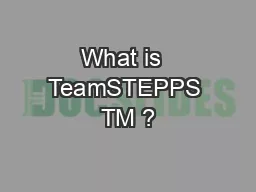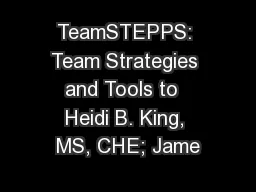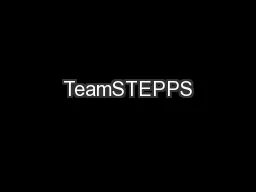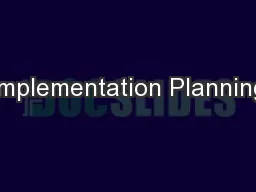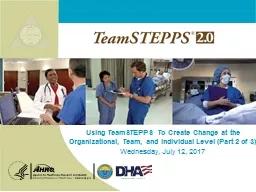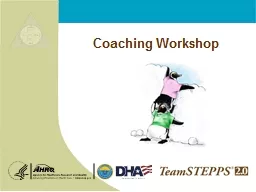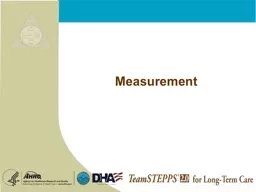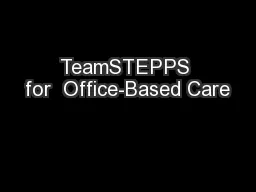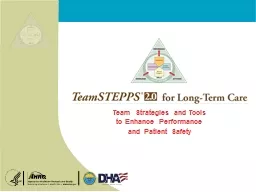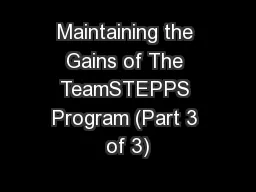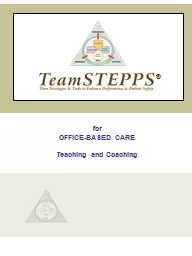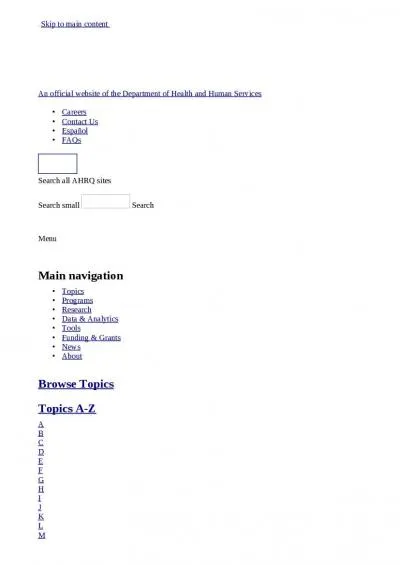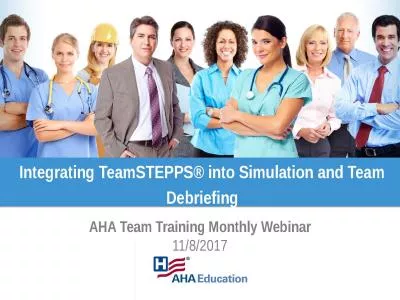PPT-What is TeamSTEPPS TM ?
Author : briana-ranney | Published Date : 2018-10-21
EvidenceBased Teamwork System Designed to improve Quality Safety Efficiency Practical amp Adaptable Background FOR INSTRUCTORS This slide will not show during the
Presentation Embed Code
Download Presentation
Download Presentation The PPT/PDF document "What is TeamSTEPPS TM ?" is the property of its rightful owner. Permission is granted to download and print the materials on this website for personal, non-commercial use only, and to display it on your personal computer provided you do not modify the materials and that you retain all copyright notices contained in the materials. By downloading content from our website, you accept the terms of this agreement.
What is TeamSTEPPS TM ?: Transcript
EvidenceBased Teamwork System Designed to improve Quality Safety Efficiency Practical amp Adaptable Background FOR INSTRUCTORS This slide will not show during the presentation TeamSTEPPS is endorsed by UNC Hospitals and . to Enhance Performance . and Patient Safety. . 2. . Ice Breaker. . 3. . Sue Sheridan Video. . 4. . Video Discussion. How are . residents . harmed as a result of. medical errors?. How can we prevent medical errors?. 5 In November 2006, AHRQ, in collaboration with thto Enhance Performance and Patient Safety (TeamSTEPPS™) as the national standard for team training in health care. TeamSTEPPS is the result of a for . Office-Based Care. Summary: Putting It All Together. Learning Objectives. Review the tools and principles of . TeamSTEPPS. Review the role of Practice Facilitators and the change team in introducing . . Objectives. Describe the steps involved in implementing TeamSTEPPS. Develop a TeamSTEPPS Implementation Plan. Shift Toward a Culture of Safety. TeamSTEPPS . Action . Planning. At-A-Glance. Create a Change Team. ). Wednesday. , July 12, 2017. Rules of Engagement . Audio for the webinar can be accessed in two ways:. Through the phone . (*Please mute your computer speakers). Through your computer. A . Q&A session will be held at the end of the presentation . Objectives. Define coaching and its outcomes. Describe the role of a TeamSTEPPS coach. List competencies of an effective coach. Describe how to implement coaching in TeamSTEPPS. TeamSTEPPS. Phases . Describe the Kirkpatrick model of training evaluation. Identify measures that can be used to assess the impact of . TeamSTEPPS. Describe the AHRQ Nursing Home Survey on Patient Safety Culture. Prepare a plan for determining if . Teaching and Coaching . Objectives. Address teaching . TeamSTEPPS. tools as a part of a. . coursework style approach where tools are divided into levels of difficulty. Define the role of a coach. Identify traits and skills of effective coaches. to Enhance Performance . and Patient Safety. Introductions. Teamwork Exercise #1. Objectives. Describe the . TeamSTEPPS. Master Trainer course. Describe the impact of errors and why they occur. Describe the . Wednesday, September 13, 2017. Rules of Engagement . Audio for the webinar can be accessed in two ways:. Through the phone . (*Please mute your computer speakers). Through your computer. A . Q&A session will be held at the end of the presentation . ®. INTRODUCTION. SAY:. Welcome to the . Coaching and Teaching module for TeamSTEPPS for Office-Based Care. . . Coaching is a good way to foster continual development and process improvement and is vital to sustaining lasting culture . November 12, 2014. . Acknowledgements. Project Sponsors. Jim Battles, PhD (AHRQ). Heidi King, MS (DoD). Project Team. Health Research & Educational Trust (HRET). Barb Edson (Project Director). Chris Hund (Project Manager). into Simulation and Team Debriefing. AHA Team Training Monthly Webinar. 11/8/2017. 2. Rules of engagement. Audio for the webinar can be accessed in two ways:. Through the . phone . (please . mute your computer speakers). : TeamSTEPPS Nurse . Education . Curriculum . Development. Brigetta D. Craft, RN, . DNP. Libba Reed McMillan, . RN, PhD. Mary Beth Maguire MSN, RN, . CNE. Sharon Wengier, MS, APRN, CNS, RNC-OB. Translating TeamSTEPPS® Concepts into the Current Curriculum.
Download Document
Here is the link to download the presentation.
"What is TeamSTEPPS TM ?"The content belongs to its owner. You may download and print it for personal use, without modification, and keep all copyright notices. By downloading, you agree to these terms.
Related Documents

